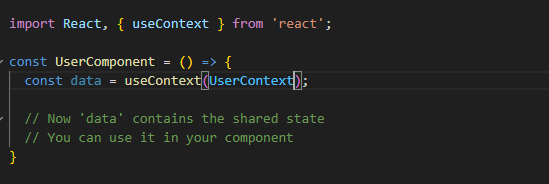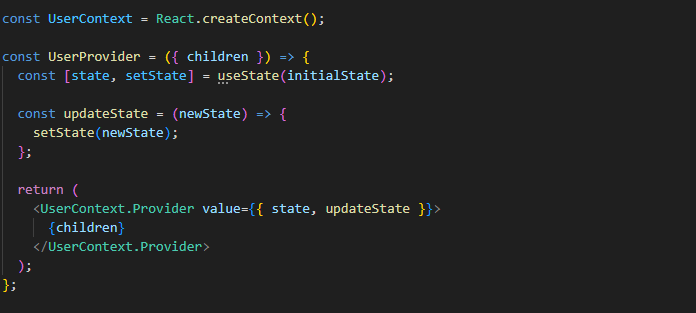Context API as State Management in React Applications
Let’s first start with what state management actually is?
State management refers to the methods and techniques used to handle, organize, and share data within a React application. It involves the systematic management and manipulation of data, ensuring seamless integration and synchronization across various components. State management is a critical aspect of building robust and efficient React applications. State management plays a pivotal role in developing dynamic and interactive applications that need to handle evolving data. This data can come from user interactions or other triggering events. By implementing robust state management techniques, React applications can maintain data integrity, enhance performance, and provide a smooth user experience.
While there are several state management libraries available, React also provides a built-in solution called the Context API. The Context API allows you to manage and share state across components without the need for prop drilling. In this blog post, we’ll explore how to use the Context API as a state management tool in your React applications.
What is Context API?
The Context API is a part of the React core library that allows you to create, read, and update a state that can be accessed by multiple components, even if they are not directly connected in the component tree. It helps you avoid passing props down through multiple levels of components, simplifying your application and making it more maintainable.
Setting Up Context:-
To get started with the Context API, you need to create a context using the “React.createContext” method. This context object will serve as a container for your shared state.

Providing and Consuming Context
- Providing Context
In order to supply data or state to your components, it is necessary to enclose them within a “Context.Provider” component. This provider component requires a ‘value’ prop, which can contain any data you wish to make available to the components.

- Consuming Context
To retrieve the shared state or data within your components, you have the option of utilizing either the “useContext” hook or the “UserContext.Consumer” component.
- Using useContext Hook:-
The useContext hook enables you to access context data within a functional component directly. The useContext accepts the value provided by React.createContext and then re-render the component whenever its value changes, but you can still optimize its performance by using memoization.

- Using UserContext.Consumer:-
If you prefer working with class components or desire greater control over when to access the context, use UserContext.Consumer components can be employed.

- Updating Context Data:-
To update the context data, it is advisable to establish functions or methods within your context that alter the state and, subsequently, expose them through the context provider.

Now, any component wrapped with UserContext.Provider can access the state and updateState function to read or modify the shared state.
Advantages of Context API
- Global Data Sharing: Context offers a means to distribute state across multiple components without passing props through intermediary components. It enables you to establish a global data flow in your application, ensuring that the state is accessible to any component that requires it.
- Eliminates Prop Drilling: Prop drilling arises when you must transmit data through numerous layers of components. Context allows you to circumvent this problem by directly supplying data to the components that require it, regardless of their location in the component hierarchy.
- Centralized State: The state is centralized, making it easier to debug and reason about your application’s behavior.
- Decreases Coupling: Employing Context enables components to be less tightly interconnected, as they do not depend on specific props being transmitted downward. Components can concentrate on their individual tasks without the burden of transmitting data through multiple levels.
- Cleaner and More Maintainable Code: By consolidating the state into a single location, the code becomes cleaner and easier to maintain. It prevents the overcrowding of components with unrelated state management logic and maintains a clear separation of concerns.
Drawbacks of Context API
- Decreased Performance: Modifying the context value can potentially trigger unnecessary re-renders in consuming components, even when the changes are irrelevant to them. This can negatively affect performance, particularly in larger component trees. It is essential to carefully assess when and how to update the context value in order to address this concern.
- Difficult to understand: Context Api makes codebase harder to understand and maintain if not used correctly. This is because the context data and state can be accessed from anywhere in the component tree, making it difficult to track where the data is being used and how it’s being updated.
- Absence of Type Safety: Context values are not inherently subject to type checking, implying that incorrect usage or alterations in the structure of the context value may go unnoticed by the compiler or development tools. This can result in runtime errors and difficulties in debugging.
Use Cases of Context API
While the Context API is a powerful tool, it may not be the best choice for every situation. Here are some guidelines for when to use it:
- Global or Application-Wide State: When you need to share state or data across multiple components in different parts of your application, the Context API simplifies the process by providing a centralized way to manage and access that state.
- Deeply Nested Components: The Context API proves particularly advantageous when handling components nested deeply within the component hierarchy. It assists in circumventing the need for prop drilling across multiple layers of components by offering a direct avenue for child components to access the context, eliminating the need to pass props through intermediate components.
- Dynamic or Changing State: In situations where the state requires frequent or dynamic updates, the Context API offers a convenient method for overseeing and modifying the state value. Components that consume the context will automatically undergo re-rendering when alterations occur in the context value.
Conclusion
The React Context API is a valuable tool for state management in your React applications. It streamlines the sharing of data between components and can enhance the maintainability and efficiency of your code. Nevertheless, it is crucial to grasp when and how to use it effectively, and to contemplate alternative state management solutions for larger and more intricate applications. By including the Context API in your toolkit, you can develop React applications that are both more scalable and easier to maintain.

